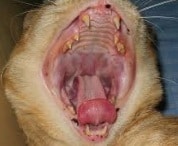 The upper and inner sector of the mouth of a vertebrate animal is called the palate . The term comes from the Vulgar Latin palatāre , in turn derived from palātum .
The upper and inner sector of the mouth of a vertebrate animal is called the palate . The term comes from the Vulgar Latin palatāre , in turn derived from palātum .
Two areas are differentiated on the palate. The hard palate , also called the bony palate , corresponds to the palatine bone and is located in front, next to the teeth . The soft palate , meanwhile, is the posterior part that is between the hard palate and the velum (a membranous and muscular sheet that establishes the separation between the oral cavity and the pharynx).
The palate is considered the roof of the mouth . In the case of the hard palate, it is specifically formed with the horizontal process of the palatine bone and the palatine process of the maxillary bone. Regarding the soft palate, it is a mobile area thanks to the muscles found in the soft palate.
The elevation and tension of the soft palate are very important. Thanks to these movements, liquids do not pass into the nasal passages during swallowing. The interaction between the tongue and the palate, on the other hand, makes the articulation of sounds possible.
It should be noted that a healthy palate has a uniform pinkish hue. The appearance of spots , therefore, can be a symptom of disease or some disorder. Spicy or very hot foods and stress, for example, can cause canker sores or ulcers on the palate. Different fungi and viruses , on the other hand, can also generate marks.
To treat inflammation in the palate, one of the first recommended measures is the application of cold. We can achieve this through water, juice or even ice cream. In addition to reducing inflammation, it can generate a sensation of numbness in the area that momentarily reduces pain. If the pain is too severe, then medication is probably necessary.
 Lastly, palate is the flavor that is detected in a food or the sensitivity that a person has to be attracted to or experience rejection towards something. In this sense, when it is said that someone has a "good palate" we are referring to their natural ability to choose the best dishes, to distinguish good preparation from mediocre one.
Lastly, palate is the flavor that is detected in a food or the sensitivity that a person has to be attracted to or experience rejection towards something. In this sense, when it is said that someone has a "good palate" we are referring to their natural ability to choose the best dishes, to distinguish good preparation from mediocre one.
In singing technique, the palate plays a fundamental role. Although in popular music academic teaching is not so common, in opera and chamber music the idea of a singer who has not educated his instrument for years, who does not know and take advantage of each component of his apparatus cannot be conceived. phonator, which is made up of the organs of respiration, phonation and articulation (in the latter is the palate).
When a singer wants to emit a note, the first thing he or she must do is take the amount of air he or she believes is necessary, which is usually very small compared to what a person without technical training takes. Next, you must expand the diaphragm to the sides to keep it in the same position and prevent it from pushing air out of the body involuntarily. Finally, the time comes to send the air towards the vocal cords, so that when touching them the desired sound is created, which must be completed by colliding with the hard palate and then resonating in the bone cavities corresponding to its height.
The singing process is much more complex, particularly if we are talking about an advanced piece of music that requires a combination of skill, memory and stamina. But the hard palate always acts, in each of the sounds , since if the air did not meet any rigid wall there would be no sound.
